Webley-Price revolver: there is no larger caliber
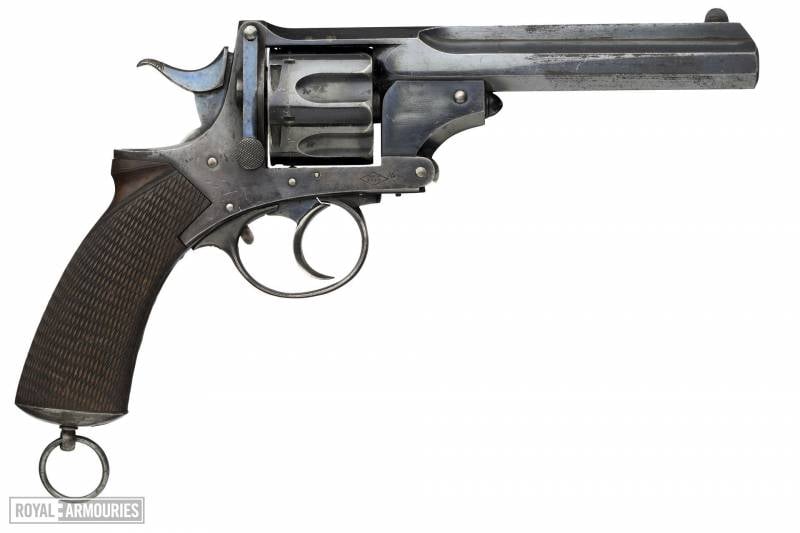
Webley-Price revolver no. 4, 1880. Probably Belgian. Length: barrel 140 mm, total length 273 mm. Weight: 1,05 kg. Caliber: .450/.476. Royal Arsenal, Leeds
And hundreds of other chimeras
You will never find a friend,
Than your combat revolver!
Didn't come off the conveyor belt -
Handmade and plan,
Systems "Vebley" or "Trenter",
Bland Price or even Varnan.
Adam Lindsay Gordon (1833–1870)
History firearms weapons. We have already talked about all the other revolvers from this poem by Lindsay Gordon: about Webley, Trenter and Varnan. Only Blend Price (PRYSE in English) remains, and today we will finally “finish it”!
Let's start by remembering the first revolvers, how big, large-caliber and ... caps they were. Then there were revolvers for hairpin cartridges, then for the cartridges of "side fire", and, finally, "central battle" with a primer in the center of the bottom of the sleeve. Following new and more and more perfect cartridges, revolvers were also improved - and multiplied not only in number, but also in their purpose. In addition to the army, numerous civilian models appeared, starting with "ladies" revolvers with mother-of-pearl handles for wearing in a muff, and ending with large-caliber ones for self-defense in the desert and jungle, and hunting! And it is clear that the dimensions and weight of the revolver depended very much on its caliber. In each army, over time, they chose their own, and this choice was the result of combat experience.
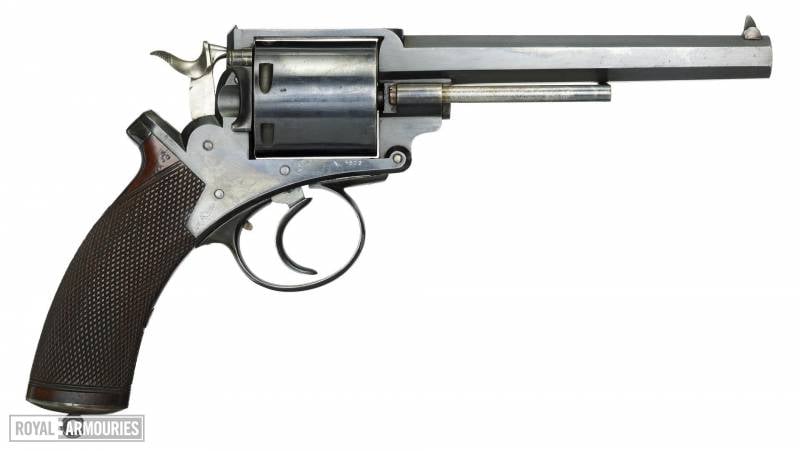
British Army revolver Adams Mk III Model 1872 Length: barrel 152 mm, overall length 286 mm. Weight: 1,065 kg. Caliber: .450. Royal Arsenal, Leeds
So, in European countries, calibers 9, 11, 12,7 mm were considered quite large. Calibers 9,4, 11,43 and above have spread to the United States. As a rule, what cavalry carbines were in use, revolvers were made of the same calibers and under the same cartridges! As for Great Britain, the first centerfire cartridge for revolvers here was the .450 Adams cartridge (11,4 mm), adopted for use in November 1868 and produced until 1880. The cartridge was used in Beaumont-Adams revolvers converted from caps in cartridge revolvers, and even gunpowder was first used in them smoky, that's what it was "ancient".
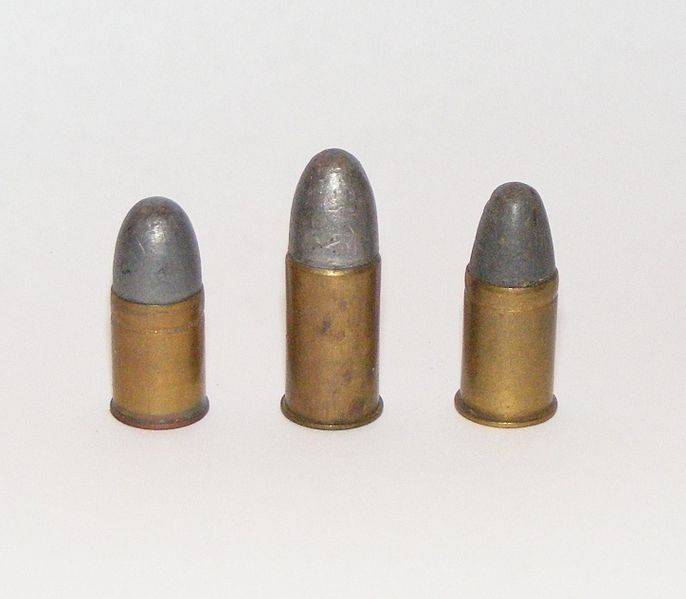
Left to right: .450 Adams, .455 Webley Mk I, .455 Webley Mk II
Interestingly, since the stocks of these cartridges were very large, they were used during the First World War, and even up to 1940!
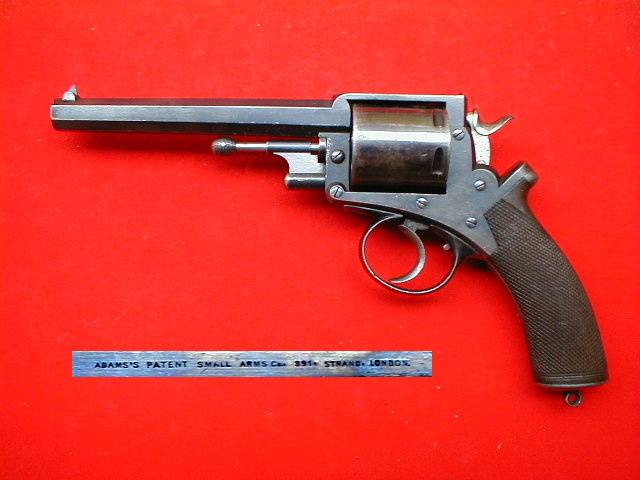
Commercial model of the Adams revolver. Photo www.littlegun.be
In 1877, Webley began production of the new .476 caliber Webley Pryse revolver, so named because it used the patents of a young Birmingham inventor, Charles Price.
And in 1876, he received a number of patents for an improved trigger system, in which the drum of a revolver at the time of the shot was fixed using a special ledge. But since Price was unable to produce his own revolvers, he began to sell licenses for his patents to a variety of firms. And the first among them was the Webley and Son company.
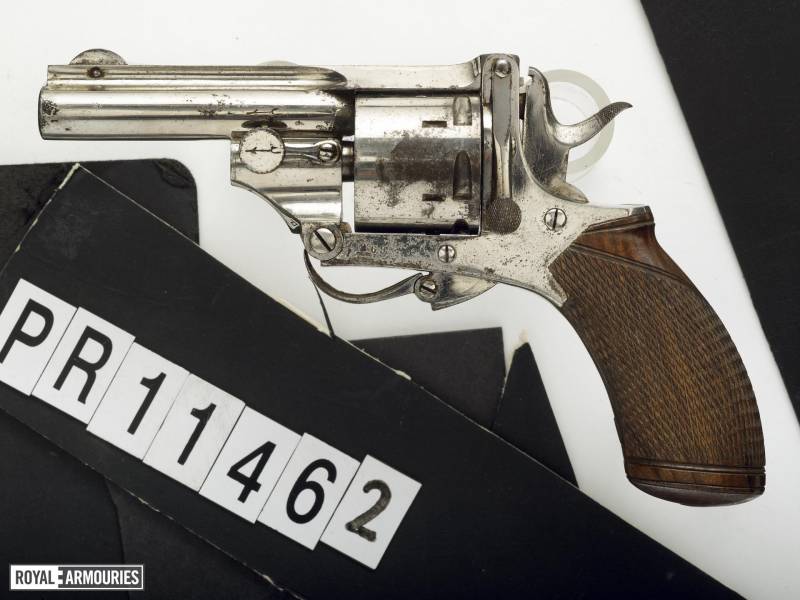
Webley-Price revolver pocket model 1880 with pull-back trigger. Length: barrel 73 mm, total length 176 mm. Weight: 0,432 kg. Caliber: .320 (7,65 mm). Royal Arsenal, Leeds
The new revolver had a frame that could be broken for reloading with simultaneous extraction of cartridges from the drum. It would seem that, just like the Smith and Wesson revolvers, which had an automatically operating extraction system, it was simply impossible to come up with something new here. However, Price proved that this was not the case. First, he came up with the original drum lock. Secondly, although his revolver did break down like a Smith and Wesson, it had a completely different upper frame mount. Otherwise, the simultaneous extraction of the sleeves was carried out.
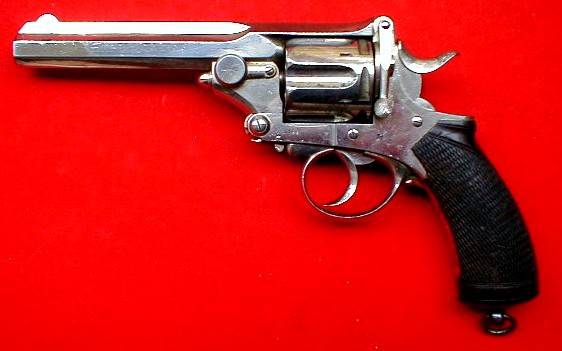
"Webley-Price" caliber 14,7 mm. View from the left. Photo www.littlegun.be
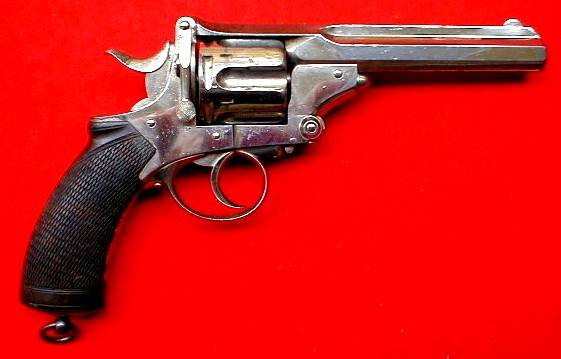
"Webley-Price" caliber 14,7 mm. Right view. Photo www.littlegun.be
The barrel of the Webley-Price revolver was octagonal and was integral with the top bar of the frame. On the front of the barrel was a lug in which a hole was drilled through which a spring-loaded rod passed, which served as the axis for the six-round drum. The drum was easily removed by unscrewing the large screw on the left side of the frame.
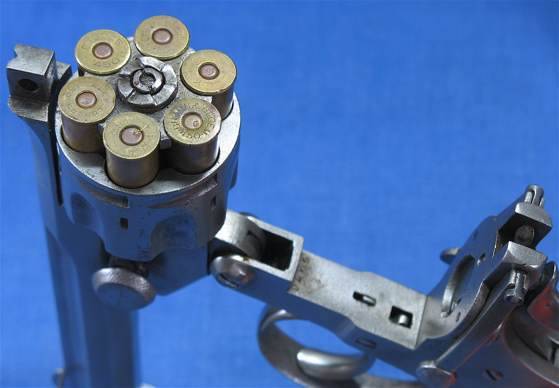
Extraction of cartridges from the drum in the model of the Kuhne-Price revolver, the manufacturer of which was the Belgian manufacturer Philippe Kuhne. Photo www.littlegun.be
The extraction of cartridge cases in it took place differently than in Smith and Wesson revolvers. The toothed extractor at Richard Price had two long plates that fit into the slots on the drum. As soon as the barrel leaned down, and the angle at the same time was about 90 °, the toothed extractor immediately automatically moved out of the drum and pushed out all the spent cartridges.
By the way, Price's revolvers could not do without the "Francott system" either! After all, the circuit breaker for the frame in them was designed specifically by Francott, and consisted of two L-shaped spring-loaded levers located vertically on the body behind the drum. When pressed, their lower ends were pressed against the body of the revolver, and the upper ones were parted to the sides and thus unlocked the lock of the frame. Revolvers with this lock design were produced in the 1890s, and in a variety of sizes and calibers, ranging from .320 caliber dwarfs to .577 "mastodons" (from 7,5 to 14,7 mm).
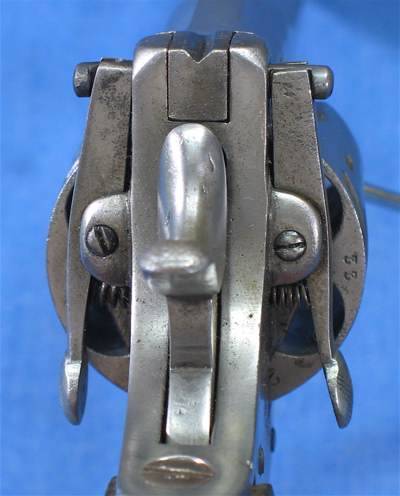
Revolver of the Kune-Price model, view of the frame locking levers. Photo www.littlegun.be
The revolver locking system consisted of two vertical levers located on both sides of the rear rack of the frame and having a flat corrugated ledge at the bottom and a short bolt at the top on the inside. Well, in order to open the frame, it was necessary to simultaneously press with your fingers on the corrugated stops at the lower ends of these levers, and in this way release the fixing protrusion in the upper frame.
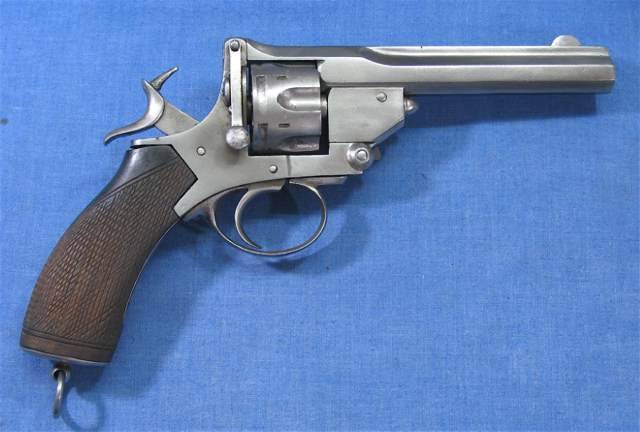
Revolver model "Kune-Price". Right view. Photo www.littlegun.be
To fix the drum, a double stopper was used, which worked from the trigger. The latch itself was a small lever connected to the trigger, which, when pressed, fell into special recesses on the surface of the drum. As soon as the drum chamber was aligned with the barrel, it could no longer turn, but with each new trigger pull, it was released and could now turn freely until the next chamber with the cartridge stood up against the barrel. Then the drum was fixed again and could no longer move even by accident.
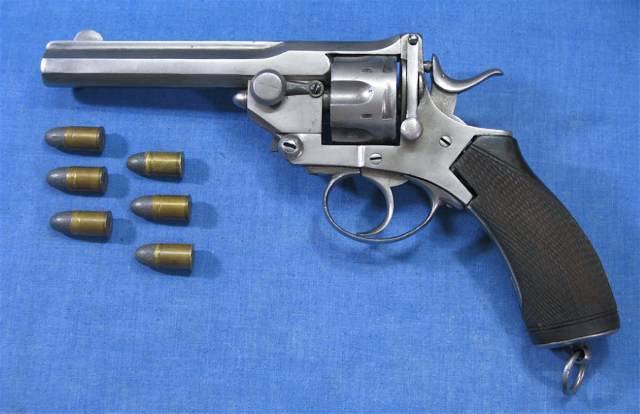
Revolver model "Kune-Price". Left view and cartridges for it. Photo www.littlegun.be
The trigger mechanism had an open trigger with a knitting needle, and allowed firing both self-cocking and pre-cocking, which, of course, increased the accuracy of shooting from such a large-caliber revolver. Another innovation was the equipment of this revolver (here it turned out to be the first such revolver) with the so-called “return trigger”, which, having broken the cartridge primer, immediately retreated, while in the deflated state the hammer striker did not come into contact with the next cartridge! Sights consisted of a front sight at the muzzle of the barrel and a rear sight cut into the rear of the top bar of the revolver frame.
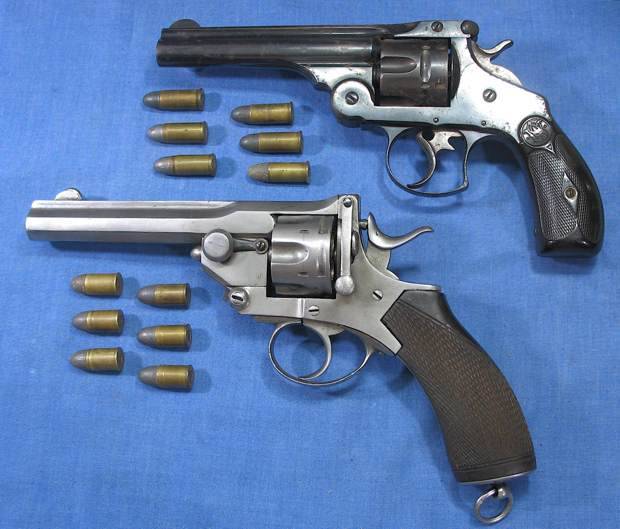
Size comparison: top, Smith & Wesson Model 1 double-action revolver, caliber .44, produced for the Russian army; at the bottom is a Webley-Price in .450 caliber. Photo www.littlegun.be
The wooden corrugated handle of the revolver ended at the bottom with a metal oval butt plate with a traditional ring for attaching a safety belt.
Revolvers were produced in a variety of calibers: .450, .455, .476, as well as .320, .380, .440, .442, .500, and even .577! However, the .450 caliber revolver, with a total length of 273 mm, and a barrel length of 146 mm, was still standard. Such a revolver without cartridges weighed about 1 kg! The drum held six rounds. The muzzle velocity of the bullet was 198 m/s.
Since the licenses to implement Charles Price's patents were sold not only to Webley, but to many other manufacturers, it is not surprising that Lindsay Gordon wrote about Blend-Price. Some kind of "blend" could then release it under license! And they were produced both in England and Belgium, and were most widely used in Europe as both military and civilian revolvers. However, "Webley" among the manufacturers of "price lists" was still the largest!
But most importantly, the "price" became popular among British officers and was widely used by both the army and the police of the British Empire in the colonial wars in South Africa against the Zulus (1879), Afghanistan (1880) and Sudan (1885) . A bullet of such a revolver, especially a 14,7 mm caliber, immediately knocked down the most fanatical dervish or tall Kaffir Zulu, although his return was very noticeable!
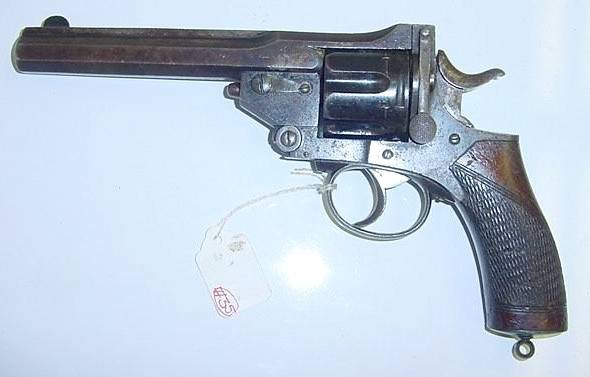
"African model" "Weblay-Price" caliber .450. Photo www.littlegun.be
The "police version" of the Webley-Price model differed from the base model mainly in a shortened barrel, a slightly modified shape of the bracket and handle (caliber .450 (11,4 mm). Length - 190 mm, barrel length - 89 mm, weight without cartridges - 0,7 kg, drum capacity - 5 rounds.
By the way, Philippe Cunet was not only a prolific arms manufacturer from Liege, but also registered 16 patents during his career. He worked closely with Auguste Francotte and D.D. Left, and produced very high-quality weapons that were widely distributed around the world!
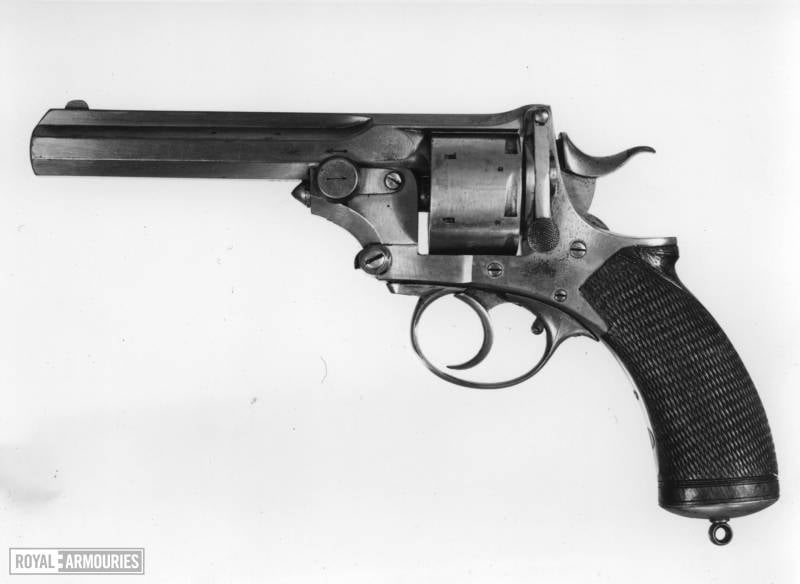
Information